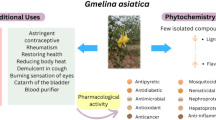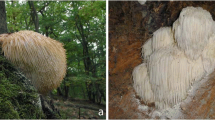Abstract
The anti-inflammatory activity of benzopyran derivatives extracted from the Myagropsis myagroides against lipopolysaccharide (LPS)-induced RAW 264.7 murine macrophage cell line was examined. The three constituents of M. myagroides extracts were identified as the sargachromanol G, sargachromanol I, and saringosterol by 1H and 13C NMR. Sargachromanol G, sargachromanol I, and saringosterol at concentrations of 50 μg/mL showed inhibitory effects on LPS induced interleukin-6 production (by 84%, 90%, and 96%, respectively) and tumor necrosis factor (by 74%, 82%, and 98%, respectively). These results confirm the potential anti-inflammatory effects of sarga-chromanol G, sargachromanol I, and saringosterol.
Similar content being viewed by others
References
Senthilkumar, K. and S. K. Kim (2013) Marine invertebrate natural products for anti-inflammatory and chronic diseases. Evid. Based Complement Alternat. Med. 2013: 572859.
Jeong, D. H., K. B. W. R. Kim, M. J. Kim, B. K. Kang, and D. H. Ahn (2014) Anti-inflammatory activity of methanol extract and n-hexane fraction mojabanchromanol b from Myagropsis myagroides. Life Sci. 114: 12–19.
Wong, C. K., V. E. C. Ooi, and P. O. Ang Jr. (2004) Hepatoprotective effect of seaweeds’ methanol extract against carbon tetrachloride-induced poisoning in rats. Hydrobiologia. 512: 267–270.
Joung, E. J., M. S. Lee, J. W. Choi, J. S. Kim, T. Shin, B. M. Jung, N. Y. Yoon, C. W. Lim, J. I. Kim, and H. R. Kim (2012) Anti-inflammatory effect of ethanolic extract from Myagropsis myagroides on murine macrophages and mouse ear edema. BMC Complement. Altern. Med. 12: 171.
Lee, S. Y., E. J. Song, K. B. W. R. Kim, S. I. Lim, Y. K. Hong, and D. H. Ahn (2011) Antimicrobial activity of Myagropsis myagroides and interaction with food composition. Food Sci. Biotechnol. 20: 85–92.
Kim, K. B. W. R., B. K. Kang, N. K. Ahn, Y. U. Choi, N. Y. Bae, J. H. Park, S. H. Park, M. J. Kim, and D. H. Ahn (2015) Inhibitory effects of Myagropsis myagroides ethanol extract on 2,4-dinitrochlorobenzene-induced atopic dermatitis-like skin lesions in mice. J. Korean Soc. Food Sci. Nutr. 44: 1121–1127.
Cha, S. H., G. N. Ahn, S. J. Heo, K. N. Kim, K. W. Lee, C. B. Song, S. K. Cho, and Y. J. Jeon (2006) Screening of extracts from marine green and brown algae in Jeju for potential marine angiotensin-I converting enzyme (ACE) inhibitory activity. J. Korean Soc. Food Sci. Nutr. 35: 307–314.
Athukorala, Y., K. W. Lee, S. K. Kim, and Y. J. Jeon (2007) Anticoagulant activity of marine green and brown algae collected from Jeju Island in Korea. Bioresour. Technol. 98: 1711–1716.
Joung, E. J., M. S. Lee, J. W. Choi, J. S. Kim. T. Shin, B. M. Jung, J. I. Kim, and H. R. Kim (2012) Anti-inflammatory effects of phlorofucofuroeckol B-rich ethyl acetate fraction obtained from Myagropsis myagroides on lipopolysaccharide-stimulated RAW 264.7 cells and mouse edema. Int. Immunopharmacol. 14: 471–480.
Heo, S. J., W. J. Yoon, K. N. Kim, G. N. Ahn, S. M. Kang, D. H. Kang, A. Affan, C. Oh, W. K. Jung, and Y. J. Jeon (2010) Evaluation of anti-inflammatory effect of fucoxanthin isolated from brown algae in lipopolysaccharide-stimulated RAW 264.7 macrophages. Food Chem. Toxicol. 48: 2045–2051.
Jang, K. H., B. H. Lee, B. W. Choi, H. S. Lee, and J. Shin (2005) Chromenes from the brown alga Sargassum siliquastrum. J. Nat. Prod. 68: 716–723.
Heo, S. J., J. Jang, B. R. Ye, M. S. Kim, W. J. Yoon, C. Oh, D. H. Kang, J. H. Lee, M. C. Kang, Y. J. Jeon, S. M. Kang, D. Kim, and K. N. Kim (2014) Chromene suppresses the activation of inflammatory mediators in lipopolysaccharide-stimulated RAW 264.7 cells. Food Chem. Toxicol. 67: 169–175.
Kim, S., M. S. Lee, B. Lee, W. G. Gwon, E. J. Joung, N. Y. Yoon, and H. R. Kim (2014) Anti-inflammatory effects of sargachromenol-rich ethanolic extract of Myagropsis myagroides on lipopolysaccharide-stimulated BV-2 cells. BMC Complement. Altern. Med. 14: 231.
Luo, X., P. Su, and W. Zhang (2015) Advances in microalgae-derived phytosterols for functional food and pharmaceutical applications. Mar Drugs. 13: 4231–4254.
Wächter, G. A., S. G. Franzblau, G. Montenegro, J. J. Hoffmann, W. M. Maiese, and B. N. Timmermann (2001) Inhibition of Mycobacterium tuberculosis growth by saringosterol from Lessonia nigrescens. J. Nat. Prod. 64: 1463–1464.
Chen, Z., J. Liu, Z. Fu, C. Ye, R. Zhang, Y. Song, Y. Zhang, H. Li, H. Ying, and H. Liu (2014) 24(S)-Saringosterol from edible marine seaweed Sargassum fusiforme is a novel selective LXRβ agonist. J. Agric. Food Chem. 62: 6130–6137.
Pak, W. M., K. B. W. R. Kim, M. J. Kim, J. Y. Cho, and D. H. Ahn (2015) Inhibitory effect of hexane fraction from Myagropsis myagroides on pancreatic α-amylase in vitro. J. Microbiol. Biotechnol. 25: 328–333.
Yoon, W. J., J. Y. Moon, G. Song, Y. K. Lee, M. S. Han, J. S. Lee, B. S. Ihm, W. J. Lee, N. H. Lee, and C. G. Hyun (2010) Artemisia fukudo essential oil attenuates LPS-induced inflammation by suppressing NF-kappaB and MAPK activation in RAW 264.7 macrophages. Food Chem. Toxicol. 48: 1222–1229.
Kofler, S., T. Nickel, and M. Weis (2005) Role of cytokines in cardiovascular diseases: a focus on endothelial responses to inflammation. Clin. Sci. 108: 205–213.
Ding, C., F. Cicuttini, J. Li, and G. Jones (2009) Targeting IL-6 in the treatment of inflammatory and autoimmune diseases. Expert Opin. Investing. Drugs. 18: 1457–1466.
Chojnacka, K., A. Saeid, Z. Witkowska, and L. Tuhy (2012) Biologically active compounds in seaweed extracts — the prospects for the application. Open Conf Proc J. 3: 20–28.
Lee, J. H., J. Y. Ko, K. Samarakoon, J. Y. Oh, S. J. Heo, C. Y. Kim, J. W. Nah, M. K. Jang, J. S. Lee, and Y. J. Jeon (2013) Preparative isolation of sargachromanol E from Sargassum siliquastrum by centrifugal partition chromatography and its anti-inflammatory activity. Food Chem Toxicol. 62: 54–60.
Akihisa, T., Y. Nakamura, M. Tagata, H. Tokuda, K. Yasukawa, E. Uchiyama, T. Suzuki, and Y. Kimura (2007) Anti-inflammatory and anti-tumor-promoting effects of triterpene acids and sterols from the fungus ganoderma lucidum. Chem. Biodivers. 4: 224–231.
Kim, K. B. W. R, M. J. Kim, S. M. Jeong, and D. H. Ahn (2019) Free radical scavenging activity and anticollagenase properties of sargachromanol I from Myagropsis myagroides. Indian J. Pharm. Sci. 81: 561–565.
Yoon, W. J., S. J. Heo, S. C. Han, H. J. Lee, G. J. Kang, H. K. Kang, J. W. Hyun, Y. S. Koh, and E. S. Yoo (2012) Anti-inflammatory effect of sargachromanol G isolated from Sargassum siliquastrum in RAW 264.7 cells. Arch. Pharm. Res. 35: 1421–1430.
Acknowledgments
This research was supported by Basic Science Research Program through the National Research Foundation of Korea (NRF) funded by the Ministry of Education (2012R1A6A1028677).
The authors declare no conflict of interest.
Neither ethical approval nor informed consent was required for this study.
Author information
Authors and Affiliations
Corresponding author
Additional information
Publisher’s Note Springer Nature remains neutral with regard to jurisdictional claims in published maps and institutional affiliations.
Rights and permissions
About this article
Cite this article
Kim, KBWR., Jeong, SM., Jeong, DH. et al. Anti-inflammatory Effects of Sargachromanol I, Sargachromanol G, and Saringosterol from Hexane Fraction of Myagropsis myagroides. Biotechnol Bioproc E 25, 16–21 (2020). https://doi.org/10.1007/s12257-019-0277-1
Received:
Revised:
Accepted:
Published:
Issue Date:
DOI: https://doi.org/10.1007/s12257-019-0277-1




